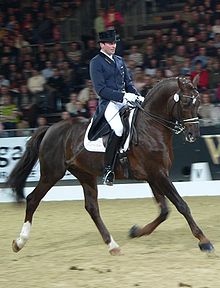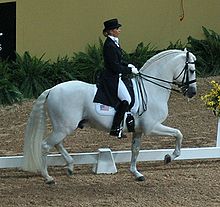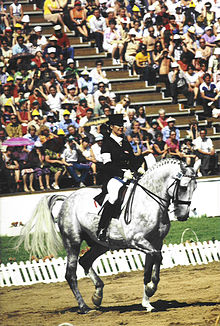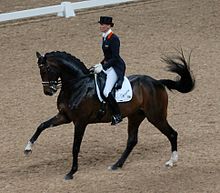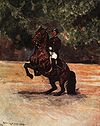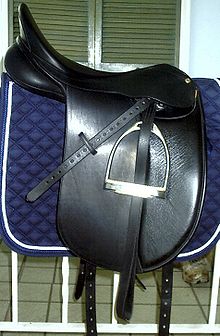- Dressage
-
Dressage (pronounced /ˈdrɛsɑːʒ/ or /drɨˈsɑːʒ/) (a French term, most commonly translated to mean "training") is a competitive equestrian sport, defined by the International Equestrian Federation as "the highest expression of horse training."[1] Competitions are held at all levels from amateur to the World Equestrian Games. Its fundamental purpose is to develop, through standardized progressive training methods, a horse's natural athletic ability and willingness to perform, thereby maximizing its potential as a riding horse. At the peak of a dressage horse's gymnastic development, the horse will respond smoothly to a skilled rider's minimal aids. The rider will be relaxed and appear effort-free while the horse willingly performs the requested movement. Dressage is occasionally referred to as "Horse Ballet". Although the discipline has ancient roots, in Europe, dressage was first recognized as an important equestrian pursuit during the Renaissance. The great European riding masters of that period developed a sequential training system that has changed little since then. Classical dressage is still considered the basis of modern dressage.
Early European aristocrats displayed their horses' training in equestrian pageants[citation needed], but in modern dressage competition, successful training at the various levels is demonstrated through the performance of "tests", prescribed series of movements ridden within a standard arena. Judges evaluate each movement on the basis of an objective standard appropriate to the level of the test and assign each movement a score from zero to ten – zero being "not executed" and 10 being "excellent". A score of 9 is very good and is a high mark, while a competitor achieving all 6s (or 60% overall) should be considering moving on to the next level.
Contents
Dressage horses
All riding horses can benefit from use of dressage principles and training techniques. However, horse breeds most often seen at the Olympics and other international FEI competitions are in the warmblood category. Dressage is an egalitarian competition in which all breeds are given an opportunity to compete successfully[citation needed]. Therefore, many other breeds are seen at various levels of competition.
In non-competitive performances of classical dressage that involve the "Airs above the ground" (described below), the "Baroque" breeds of horses, most notably the Lipizzaner, are seen most often.
The arena
There are two sizes of arenas: small and standard. Each has letters assigned to positions around the arena for dressage tests to specify where movements are to be performed.
The small arena is 20 m by 40 m (66x131 ft), and is used for the lower levels of eventing in the dressage phase, as well as for the USDF Introductory tests and the USEF Training Level tests. Its letters around the outside edge, starting from the point of entry and moving clockwise, are A-K-E-H-C-M-B-F. A number of mnemonic devices are used to remember this sequence, such as the phrase "All King Edwards' Horses Can Make Big Fences." Letters also mark locations in the middle of the arena: Moving down the center line, they are D-X-G, with X in the center. Since the combination of Equine Canada (EC) and United States Dressage Federation (USDF) tests in 2003, the small size arena is no longer utilized in rated shows in North America.
The standard arena is 20 m by 60 m (66x197 ft), and is used for tests in both dressage (USEF First Level and above) and eventing. The standard dressage arena letters are A-K-V-E-S-H-C-M-R-B-P-F. (There is speculation as to why these letters were chosen. Most commonly it is believed because the German cavalry had a 20 x 60 meter area in between the barracks which had the letters posted above the doors) The letters on the long sides of the arena, nearest the corners, are 6 m (19.7 ft) in from the corners, and are 12 m (39.4 ft) apart from each other. The letters in the middle of the arena are D-L-X-I-G, with X marking the center line. At the start of the test, the horse enters at A. There is always a judge sitting at C, although for upper-level competition, there are up to five judges at different places around the arena—at C, E, B, M, and H—which allows the horse to be seen in each movement from all angles. This helps prevent certain faults from going unnoticed, which may be difficult for a judge to see from only one area of the arena. For example, the horse's straightness going across the diagonal may be assessed by judges at M and H. Judges in the United States are licensed by the USEF for different levels of competition, depending on the judge's experience and training.
The dressage arena also has a centerline (from A to C, going through X in the middle), as well as two quarter-lines (halfway between the centerline and long sides of each arena).
Competition
Dressage competitions may begin in local communities with introductory level classes where riders need only walk and trot. Horses and riders advance through a graduated series of Nationally defined levels, with tests of increasing difficulty at each level. The most accomplished horse and rider teams perform the FEI tests, written by an international committee called the Fédération Équestre Internationale or FEI. The highest level of modern competition is at the Grand Prix level. This is the level test ridden in the prestigious international competitions, such as the Olympic games.
Dressage at the international level under the rules of the FEI (Federation Equestre Internationale) consists of the following levels: Prix St. Georges, Intermediare I, Intermediare II and Grand Prix. In addition, there are four to six lower levels, occasionally more, regulated in individual nations. The lower levels ask horses for basic gaits, relatively large circles, and a lower level of collection than the international levels. Lateral movements are not required in the earliest levels, and movements such as the leg yield, shoulder-in, or haunches-in are gradually introduced as the horse progresses.
Apart from competition, there is a tradition of classical dressage, in which the tradition of dressage is pursued as an art form. The traditions of the masters who originated Dressage are kept alive by the Spanish Riding School in Vienna, Austria and the Cadre Noir in Saumur, France. This type of schooling is also a part of Portuguese and Spanish bullfighting exhibitions.
Tests
Dressage tests are the formalized sequence of a number of dressage movements used in competition. Although horses and riders are competing against each other, tests are completed by one horse and rider combination at a time, and horses and riders are judged against a common standard, rather than having their performance scored relative to the other competitors.
At the upper levels, tests for International competitions, including the Olympics, are issued under the auspices of the Federation Equestre Internationale. At the lower levels, and as part of dressage training each country authorizes its own set of tests. In the USA it is the United States Equestrian Federation and the United States Dressage Federation. Pony Clubs also produce basic walk/trot tests. The British Dressage Federation has similar rules.
Each test is segmented into a number of sequential blocks which may contain one or more movements. Each block is generally scored between one and ten on a scale such as the following:
- 10 Excellent
- 9 Very good
- 8 Good
- 7 Fairly good
- 6 Satisfactory
- 5 Sufficient
- 4 Insufficient
- 3 Fairly Bad
- 2 Bad
- 1 Very bad
- 0 Not performed[2]
In addition to marks for the dressage movements, marks are also awarded for more general attributes such as the horse's gaits, submission, impulsion and the rider’s performance. Some segments are given increased weight by the use of a multiplier, or coefficient. Coefficients are typically given a value of 2, which then doubles the marks given for that segment.[3] Movements that are given a coefficient are generally considered to be particularly important to the horse's progression in training, and should be competently executed prior to moving up to the next level of competition. The scores for the general attributes of gait, submission, impulsion, and rider performance mentioned above are scored using a coefficient.
Scribing
Scribing (also known as Penciling) is the writing down of the scores and comments of Judges at dressage events, so that the Judge is able to concentrate on the performance. In addition to this the scribe should check the identity of each competitor, and ensure that the test papers are complete and signed before handing them to the scorers. The scribe should have some knowledge of dressage terminology, be smartly dressed and have legible handwriting. The scribe should also be professional in manner, neutral and not engage in small talk or make comments. It is permissible to use abbreviations provided they are accepted and intelligible.[4]
According to the United States Dressage Federation, "Anyone can volunteer at a schooling show to scribe. Schooling shows are not recognized as official shows but are a great way to practice riding tests or to learn to scribe for a judge. Once you have scribed at a schooling show and at the lower levels, you may ask to scribe at a recognized show and perhaps even the FEI levels of competition."[5]
International level
At the international level, dressage tests governed by the FEI are the Prix St. Georges, Intermediare I, Intermediare II, and Grand Prix. The dressage tests performed at the Olympic Games Dressage competition are Grand Prix. This level of test demands the most skill and concentration from both horse and rider.
Movements included in Grand Prix dressage tests are:
- Piaffe
- A calm, composed, elevated trot in place (although minimal movement forward is allowed and not penalized in competitions as it is the natural way of performing the movement)
- Passage
- A very collected trot, in which the horse has great elevation of stride and seems to pause between putting down its feet (it has a great amount of suspension in the stride). Described very well like a horse "trotting under water", it takes great strength and training to get a good passage.
Ideally in both the piaffe and the passage tempo should be exactly the same as in trot.
- Extended gaits
- Usually done at the trot and canter, the horse lengthens its stride to the maximum length through great forward thrust and reach. Grand Prix horses show amazing trot extensions. Though not as visually impressive, equally important is the extended walk, which shows that the horse can easily relax and stretch in the midst of the more collected movements.
- Collected gaits (trot and canter)
- A shortening of stride in which the horse brings its hindquarters more underneath himself and carries more weight on his hind end. The tempo does not change, the horse simply shortens and elevates his stride.
- Flying changes in sequence
- Informally called "tempi" at this level, The horse changes leads at the canter every stride (one tempi or "oneseys"), two strides (two tempi), or three strides (three tempi).
- Pirouette
- A 360 or 180 (depending on the level) degree turn in place, usually performed at the canter. In a Freestyle to music (kür) test, a turn of up to 720° is permissible for Grand Prix.
- Half-pass
- A movement where the horse goes on a diagonal, moving sideways and forward at the same time, while bent slightly in the direction of movement.
Tests ridden at the Olympic Games are scored by a panel of seven international judges. Each movement in each test receives a numeric score from 0 (lowest) to 10 (highest) and the resulting final score is then converted into a percentage, which is carried out to three decimal points. The higher the percentage, the higher the score.
Olympic team medals are won by the teams with the highest, second highest, and third highest total percentage from their best three rides in the Grand Prix test.
Once the team medals are determined, horses and riders compete for individual medals. The team competition serves as the first individual qualifier, in that the top 25 horse/rider combinations from the Grand Prix test move on to the next round. The second individual qualifier is the Grand Prix Special test, which consists of Grand Prix movements arranged in a different pattern. For those 25 riders, the scores from the Grand Prix and the Grand Prix Special are then combined and the resulting top 15 horse/rider combinations move on to the individual medal competition—the crowd-pleasing Grand Prix Freestyle to Music (Kür).
For their freestyles, riders and horses perform specially choreographed patterns to music. At this level, the freestyle tests may contain all the Grand Prix movements, as well as double canter pirouettes, pirouettes in piaffe, and half-pass in passage. For the freestyle, judges award technical marks for the various movements, as well as artistic marks. In the case of a tie, the ride with the higher artistic marks wins.
The Training Scale
The dressage training scale is often arranged in a pyramid or sequential fashion, with “rhythm and regularity” at the start of the pyramid and “collection” at the end. The training scale is helpful and effective as a guide for the training of any horse, but has come to be most closely associated with dressage.[6] Despite its appearance, the training scale is not meant to be a rigid format. Instead, each level is built on as the horse progresses in training: so a Grand Prix horse would work on the refinement of the first levels of the pyramid, instead of focusing on only the final level: “collection.” The levels are also interconnected. For example, a crooked horse is unable to develop impulsion, and a horse that is not relaxed will be less likely to travel with a rhythmic gait. However, this training scale as presented below is a translation from the German to the English. As such, it is possibly not as accurate as it could be. It has been suggested, for example, that Losgelassenheit might be more accurately translated as "Suppleness."
Rhythm and Regularity (Takt)
Rhythm, gait, tempo, and regularity should be the same on straight and bending lines, through lateral work, and through transitions. Rhythm refers to the sequence of the footfalls, which should only include the pure walk, pure trot, and pure canter. The regularity, or purity, of the gait includes the evenness and levelness of the stride. Once a rider can obtain pure gaits, or can avoid irregularity, the combination may be fit to do a more difficult exercise. Even in the very difficult piaffe there is still regularity: the horse "trots on the spot" in place, raising the front and hind legs in rhythm.
Relaxation (Losgelassenheit)
The second level of the pyramid is relaxation (looseness). Signs of looseness in the horse may be seen by an even stride that is swinging through the back and causing the tail to swing like a pendulum, looseness at the poll, a soft chewing of the bit, and a relaxed blowing through the nose. The horse makes smooth transitions, is easy to position from side to side, and willingly reaches down into the contact as the reins are lengthened.
Contact (Anlehnung)
Contact—the third level of the pyramid—is the result of the horse’s pushing power, and should never be achieved by the pulling of the rider’s hands. The rider encourages the horse to stretch into soft hands that allow the horse to lift the base of the neck, coming up into the bridle, and should always follow the natural motion of the animal’s head. The horse should have equal contact in both reins.
Impulsion (Schwung)
The pushing power (thrust) of the horse is called impulsion, and is the fourth level of the training pyramid. Impulsion is created by storing the energy of engagement (the forward reaching of the hind legs under the body).
Proper impulsion is achieved by means of:
- Correct driving aids of the rider
- Relaxation of the horse
- Throughness (Durchlässigkeit): the flow of energy through the horse from front to back and back to front. The musculature of the horse is connected, supple, elastic, and unblocked, and the rider’s aids go freely through the horse.
Impulsion can occur at the walk, trot and canter. It is highly important to establish good, forward movement and impulsion at the walk, as achieving desirable form in the trot and canter relies heavily on the transition from a good, supple, forward walk.
Impulsion not only encourages correct muscle and joint use, but also engages the mind of the horse, focusing it on the rider and, particularly at the walk and trot, allowing for relaxation and dissipation of nervous energy.
Straightness (Geraderichtung)
A horse is straight when the hind legs follow the path of the front legs, on both straight lines and on bending lines, and the body follows the line of travel. Straightness allows the horse to channel its impulsion directly toward its center of balance, and allows the rider’s hand aids to have a connection to the hind end.
Collection (Versammlung)
At the apex of the training scale stands collection. It may refer to collected gaits: they can be used occasionally to supplement less vigorous work. It involves difficult movements (such as flying changes) in more advanced horses. Collection requires greater muscular strength, so must be advanced upon slowly. When in a collected gait, the stride length should shorten, and the stride should increase in energy and activity.
When a horse collects, more weight moves to the hindquarters. Collection is natural for horses and is often seen during pasture play. A collected horse is able to move more freely. The joints of the hind limbs have greater flexion, allowing the horse to lower the hindquarters, bringing the hind legs further under the body, and lighten and lift the forehand. In essence, collection is the horse's ability to move its centre of gravity to the rear.
"Airs" above the ground
The "school jumps," or "airs above the ground" are a series of higher-level classical dressage movements where the horse leaves the ground. These include the capriole, courbette, the mezair, the croupade, and levade. None are used in modern competitive dressage, but are performed by horses of various riding academies, including the Spanish Riding School in Vienna and the Cadre Noir in Saumur. Baroque horse breeds such as the Andalusian, Lusitano and Lipizzan are most often trained to perform the "airs" today, in part due to their powerfully conformed hindquarters, which allow them the strength to perform these difficult movements.
There is a popular belief that these moves were originally taught to horses for military purposes, and indeed both the Spanish Riding School and the Cadre Noir are military foundations. However, while agility was necessary on the battlefield, most of the airs as performed today would have actually exposed horses' vulnerable underbellies to the weapons of foot soldiers.[7] It is therefore more likely that the airs were exercises to develop the agility, responsiveness and physiology of the military horse and rider, rather than to be employed in combat.
Dressage masters
The earliest practitioner who wrote treatises that survive today that describe sympathetic and systematic training of the horse was the Greek general Xenophon (427–355 BC). Despite living over 2000 years ago, his ideas are still widely praised. Beginning in the Renaissance a number of early modern trainers began to write on the topic of horse training, each expanding upon the work of their predecessors, including Federico Grisone (mid-16th century), Antoine de Pluvinel (1555–1620), William Cavendish, 1st Duke of Newcastle (1592–1676), François Robichon de La Guérinière (1688–1751), François Baucher (1796–1873), and Gustav Steinbrecht (1808–1885). The 20th century saw an increase in writing and teaching about Dressage training and techniques as the discipline became an international sport with the influence of Olympic Equestrian competition.
Tack
All dressage competitors in the USA are urged to consult the current rules for tack, equipment, etc., provided at www.USEF.org The rules on permitted cavessons (nosebands) saddles, saddle pads, etc., are subject to change and do change as more and more styles and stylish equipments are introduced into the marketplace. Dressage horses are shown in minimal tack. They are not permitted to wear boots (including hoof or bell boots) or wraps (including tail bandages) during the test, nor are they allowed to wear martingales or training devices such as draw or running reins or the gogue anywhere on the showgrounds during the competition. Due to the formality of dressage, tack is usually black leather, although dark brown is seen from time to time.
An English-style saddle is required for riding dressage, specifically a "dressage saddle" which is modeled exclusively for the discipline. It is designed with a long and straight saddle flap, mirroring the leg of the dressage rider, which is long with a slight bend in the knee, a deep seat and usually a pronounced knee block. Dressage saddles have longer girth straps and use shorter girth than other types of English saddles to minimize the straps and buckles underneath the rider's legs. The saddle is usually placed over a square, white saddle pad. Colored trim on the white saddle pad is permitted.[8] A dressage saddle is required in FEI classes, although any simple English-type saddle may be used at the lower levels.
At the lower levels of dressage, a bridle includes a plain cavesson, drop noseband, or flash noseband. Currently, drop nosebands are relatively uncommon, with the flash more common. At the upper levels a plain cavesson is used on a double bridle. Figure-eight (also called Grackle) nosebands are not allowed in pure dressage, however they are allowed in the dressage phase of eventing.[9] Riders are not allowed to use Kineton nosebands, due to their severity. Beads and colored trim are permitted along the brow band of the bridle.[8]
The dressage horse at lower levels is only permitted to be shown at recognized competitions in a snaffle bit, though the detail regarding bitting varies slightly from organization to organization. The loose-ring snaffle with a single- or double-joint is most commonly seen. Harsher snaffle bits, such as twisted wire, corkscrews, slow-twists, and waterfords are not permitted, nor are pelhams, kimberwickes, or gag bits. Upper level and FEI dressage horses are shown in a double bridle, using both a bradoon and a curb bit with a smooth curb chain.
Turnout of the horse
Dressage horses are turned out to a very high standard, as competitive dressage is descended from royal presentations in Europe. It is traditional for horses to have their mane braided. In eventing, the mane is always braided on the right. In competitive dressage, however, it is occasionally braided on the left, should it naturally fall there. Braids vary in size depending on the conformation of the horse, but Europeans tend to put in fewer, larger braids, while horses in the United States usually have more braids per horse (possibly from the influence of hunter-style riding in the country). Braids are occasionally accented in white tape, which also helps them stay in throughout the day. The forelock may be left unbraided; this style is most commonly seen on stallions.
Horses are not permitted to have bangles, ribbons, or other decorations in their mane or tail. Tail extensions are permitted in some countries, but not in international competition.
The tail is usually not braided (although it is permitted), because it may cause the horse to carry the tail stiffly. Because the tail is an extension of the animal's spine, a supple tail is desirable as it shows that the horse is supple through its back. The tail should be "banged," or cut straight across (usually above the fetlocks but below the hocks when held at the point where the horse naturally carries it). The dock is pulled or trimmed to shape it and give the horse a cleaner appearance.
The bridle path is clipped or pulled, usually only 1–2 inches. The animal's coat may or may not be trimmed. American stables almost always trim the muzzle, face, ears, and legs, while European stables do not have such a strict tradition, and may leave different parts untrimmed.
Hoof polish is usually applied before the horse enters the arena. The horse is impeccably clean, with a bathed coat and sparkling white markings. The horse's saliva often forms "foam" about the horse's lips, and is generally considered to be a sign of the horse's submission and acceptance of the bit. Some riders believe that foam should not be cleaned off the horse's mouth before entering the arena due to its status as a sign of submission. Conversely, some riders choose the wipe the foam from their horse's mouth prior to entering the arena, as it can drip from the horses mouth and land on the horse's chest and legs. It should be noted that the presence of foam does not necessarily indicate the horse's acceptance of the bit, as certain metals such as German silver may cause the horse's salivation to increase without full acceptance of the bit.
Quarter marks are sometimes seen, especially in the dressage phase of eventing, however they are not currently in style for competitive dressage.
Rider clothing
Dressage riders, like their horses, are dressed for formality. In competition, they wear white breeches, often full-seat leather to help them "stick" in the saddle, with a belt, and a white shirt and stock tie with a small pin. Gloves are usually white, although less-experienced riders or those at the lower levels often opt for black, as white gloves tend to accentuate the movement of a less-experienced rider's unsteady hands. The coat worn is usually solid black with metal buttons, although solid navy is also seen. Dressage coats differ from traditional hunt coats in that dressage coats have four buttons, while hunt coats have three. In upper-level classes, the riders wear a shadbelly with a yellow vest or vest points instead of a plain dressage coat.
Riders usually wear tall dress boots, although field boots may be worn by riders at the lower levels. Spurs are required at the upper levels, and riders must maintain a steady lower leg for proper use. A whip may be carried in any competition except in a CDI or a national championship, and the length is regulated. Whips are not permitted in eventing dressage.
If the dressage rider has long hair, it is typically worn in a bun with a hair net or show bow. A hair net blends in with the rider's hair color, whereas a show bow combines a barrette or hair tie with a small bow and thick hair net, and is usually black. Lower-level riders may use a derby, hunting cap, or ASTM/SEI-approved Equestrian helmet. In the United States, junior riders at recognized competitions are required to wear an ASTM/SEI approved helmet to protect against head trauma in the event of a fall. At the upper levels, a top hat that matches the rider's coat is traditionally worn, though in some competitions, an ASTM/SEI approved helmet is show legal.
If the rider is a member of the police or military, they are permitted to wear their respective uniform during competition.
See also
Notes
- ^ About Dressage, International Equestrian Federation, retrieved August 26, 2011
- ^ 2010 USEF Rule Book, dressage division, Rule DR-122
- ^ United States Equestrian Federation, 2009 Dressage Rules. Accessed October 21, 2008
- ^ see, e.g. Dressage Canada scribing guide
Scribing symbols - ^ USDF | About | About Dressage | Competition | Judging & Scribing
- ^ McNeil, Hollie H., 40 Fundamentals of English Riding, Storey Publishing, 2011, p.83
- ^ Chamberlin, J. Edward. Horse: How the Horse Has Shaped Civilizations. Bluebridge, 2006, p. 166-167 ISBN 0-9742405-9-1
- ^ a b USDF | About | About Dressage | Competition | Judging & Scribing
- ^ http://www.britishdressage.co.uk/uploads/File/Rules%202009/BD%20rulebook%202009%202.pdf
References
- Burns, T. E. & Clayton, H. M. (1997) "Comparison of the temporal kinematics of the canter pirouette and collected canter". Equine Veterinary Journal Supplement; 23, 58–61.
- Blackfern (2005) Printable Arena Diagram
- Barretto de Souza, Joseph, Count (192-?) & (1927) Elementary Equitation and Advanced Equitation. New York: E. P. Dutton & Co (?) // London: John Murray
- Clayton, H. M. (1997). "Classification of collected trot, passage and piaffe using stance phase temporal variables". Equine Veterinary Journal Supplement 23 (23): 54–57. PMID 9354290.
- Clayton, H. M. (1995). "Comparison of the stride kinematics of the collected, medium, and extended walks in horses". American Journal of Veterinary Research 56 (7): 849–852. PMID 7574149.
- Clayton, H. M. (1994). "Comparison of the stride kinematics of the collected, working, medium, and extended trot". Equine Veterinary Journal 26 (3): 230–234. doi:10.1111/j.2042-3306.1994.tb04375.x. PMID 8542844.
- Clayton, H. M. (1994). "Comparison of the collected, working, medium, and extended canters". Equine Veterinary Journal Supplement 17: 16–19.
- German National Equestrian Federation (1990) The Principles of Riding. Boonsboro, Md:Half Halt Pr.
- Advanced Techniques of Riding (1987) (Official Handbook of the German National Equestrian Federation) English edition, Boonsboro, Md: Half Halt Press.
- Herbermann, Erik (1993). Dressage Formula. London: J. A. Allen & Co.
- McNeil, H (2011)40 Fundamentals of English Riding. North Adams, MA: Storey, ISBN 978-1-60342-789-0
- Minetti, A. (1998) "The biomechanics of skipping gaits: a third locomotion paradigm?" Proceedings of the Royal Society of London: part B, 265(1402): 1227–1235.
- Museler, Wilhelm Riding Logic. New York: Simon & Schuster, ISBN 0-671-76492-6 (translation first published: London: Methuen, 1937; many later editions)
- Santini, Piero (1936) The Forward Impulse. London: Country Life
- Wynmalen, Henry (1953) Dressage: a study of the finer points of riding. London: Museum Press
- (also, by the same author, Equitation. London: Country Life, 1938)
External links
- Federation Equestre Internationale (FEI)
- US Equestrian Federation
- US Dressage Federation
- British Dressage
- Dressage Canada
- Equestrian Federation of Kazakhstan Russian – Equestrian Federation of Kazakhstan English
- Spanish Riding School
Categories:
Wikimedia Foundation. 2010.

